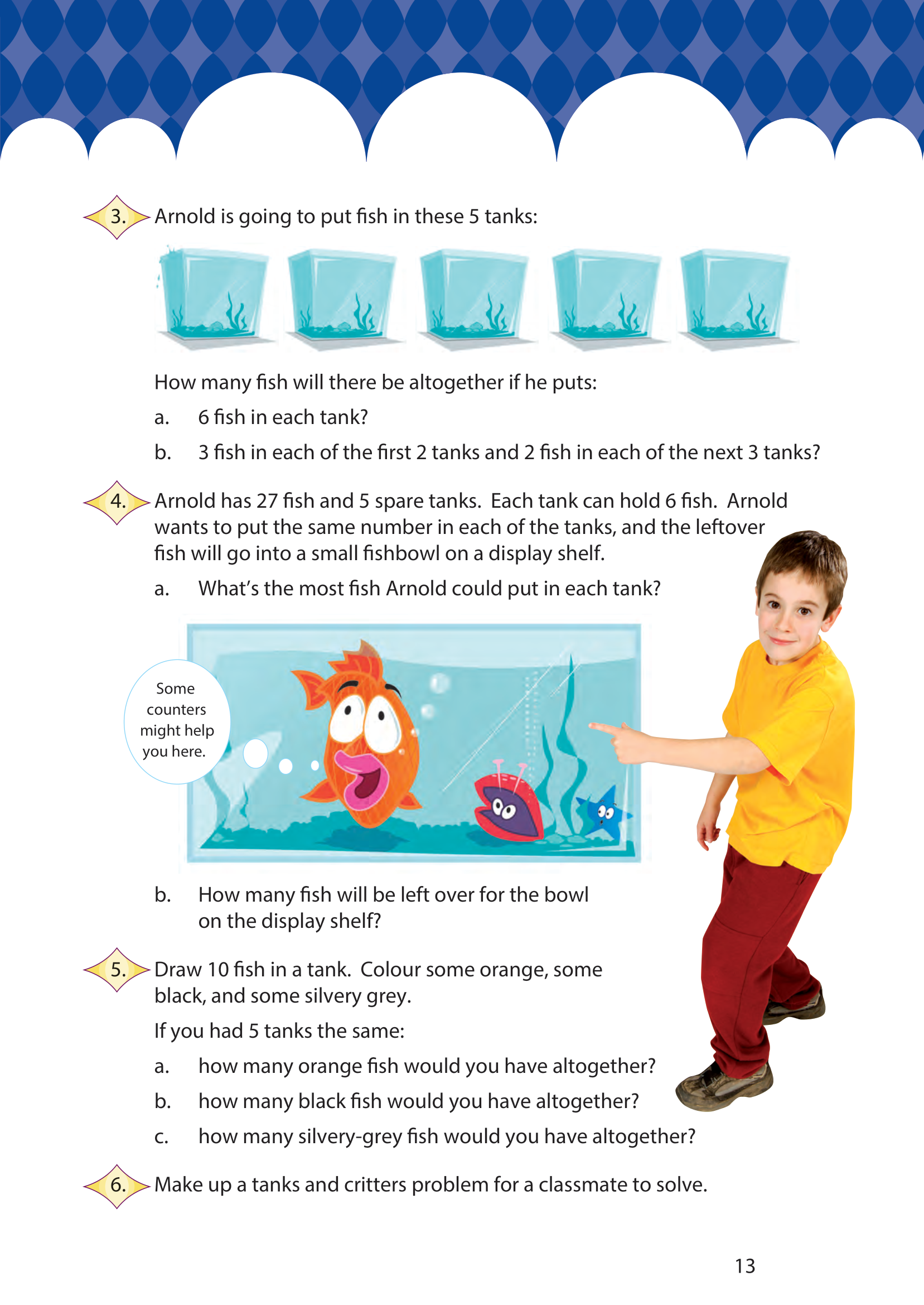This is a level 2 number activity from the Figure It Out series. It relates to Stage 5 of the Number Framework.
Click on the image to enlarge it. Click again to close. Download PDF (740 KB)
use repeated addition to solve multiplication problems
Number Framework Links
This activity would be ideal for students at stage 4 who are being helped to move on from using additive strategies. Students at stage 5 may still need some guidance, while students at stage 6 should be able to use this as an independent activity
Counters (optional)
FIO, Levels 2-3, Multiplicative Thinking, Fishy Business, pages 12-13
A classmate
This activity provides a rich context for seeing division and multiplication as inverse operations and encourages students to use multiplication to express an “equal-groups” model of multiplication. When equal-groups problems are posed to students, they often respond with a repeated addition or skip-counting strategy rather than seeing it as a multiplication. The structure of an equal-groups situation prompts this response because it is a repetition of one group: an obvious response is to start with the first group and add on the next and so on. Multiplication, however, provides a more powerful and easier way to solve these problems, one that will work when the numbers are too big for efficient addition.
Arnold’s log book in question 1 explicitly shows the repeated addition strategy. However, Hint Crab shows a shorter way, using multiplication instead. Discuss with your students what Hint Crab is saying. Is this true? Can you explain why? Use materials to help you explain … The students are then given the opportunity to apply this to the other critters to see if they can generalise the idea. They may need to write the additions first and then say the groupings aloud, as in the hint, in order to remember that what they are looking for is “How many groups?” You may need to remind the students that each tank contains 1 group of a particular critter.
Question 2 works the other way, with critters going into the tanks. The multiplication is times 10 (because there are 10 tanks). This should be straightforward, but because there are two groupings of critters in each tank, discussion may be necessary to establish this. Arnold’s speech bubble provides a clue. Going back to using materials might help students to model the situation, but remember that the aim of this is to use multiplication rather than to skip-count or add, so once students have sorted out their thinking by modelling the tanks, you could shield the model to encourage using multiplicative strategies.
For question 3, discuss how the students might solve the problem and then use modelling if necessary. Encourage the students to include a multiplication equation as a part of their answers.
Students at stages 4 and 5 may need to use counters for question 4. However, before they do use materials, prompt them to think about the numbers to see if they can solve each part of the question without modelling. Point out that they know the total number of fish and the number of groups (tanks) to share them into; their task is to find the number of fish in each group.
Questions 5 and 6 are useful summary activities that a group of students could go and do independently or in pairs following your discussion. Their answers will vary, so you could begin your next session with them by having them share their ideas. You might want to use a small magnetic whiteboard or piece of card to be a “fish tank”. Ask the students to draw some critters and put magnets or something sticky on the back of them. They can then put some critters “in” the tank. If you then specify how many tanks there are, they can work out how many critters altogether. In this way, you can generate lots of multiplications to work out, perhaps as part of a whole-class warm-up.
Answers to Activity
1. a. 4 x 10 = 40 orange fish
b. 4 x 3 = 12 starfish
c. 4 x 2 = 8 crabs
2. a. 30 fish. (10 x 3 = 30)
b. 40 snails. (10 x 4 = 40)
3. a. 30 fish. (5 x 6 = 30)
b. 12 fish. (2 x 3 = 6 plus 3 x 2 = 6. 6 + 6 = 12 or 2 x 6 = 12.)
4. a. 5 fish in each tank. (The tanks hold 6 fish, but 6 x 5 = 30, and Arnold only has 27 fish. 5 x 5 = 25)
b. 2 fish left over: 5 x 5 = 25, 27 – 25 = 2.
5. a.–c. Answers will vary. You could use your 5 times table to help you. For example, if you had 5 tanks with 2 orange fish in each one, you could say you had 5 x 2 = 10 orange fish altogether.
6. Problems will vary.

